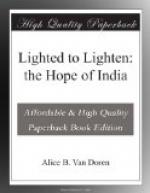Organized play is one of the gifts that school life brings to India. It, too, has to be learned, for the Indian girl has had no home training in initiative. The family or the caste is the unit and she is a passive member of the group, whose supreme duty is implicit obedience. One Friday when school had just reopened after the Christmas vacation, one of the teachers came to the principal and said, “May we stop all classes this afternoon and let the children play? You see,” as she saw remonstrance forthcoming, “it’s just because it’s been vacation. They say they have been so long at home and there has been no chance to play.” Classes were stopped, and all the school played, from the greatest unto the least, until the newly aroused instinct was satisfied.
Basket ball had an interesting history in one school. At first the players were very weak sisters, indeed. The center who was knocked down wept as at a personal affront, and the defeated team also wept to prove their penitence for their defeat. But gradually the team learned to play fair, to take hard knocks, and to cheer the winners. They grew into such “good sports” that when one day an invading cow, aggrieved at being hit in the flank by a flying ball, turned and knocked the goal thrower flat on the ground, the interruption lasted only a few minutes. The prostrate goal-thrower recovered her breath, got over her fright, and, while admiring friends chased the cow to a safe distance, the game went on to the finish.
Dramatics.
The dramatic instinct is strong and the school girl actress shines, whether in the role of Ophelia or Ramayanti. In India among Hindus or Christians, in school or church or village, musical dramas are frequently composed and played and hold unwearied audiences far into the night. Among Christians there is a great fondness for dramatizing Bible narratives. Joseph, Daniel, and the Prodigal Son appear in wonderful Indian settings, “adapted” sometimes almost beyond recognition. They show interesting likeness to the miracle and mystery plays of the Middle Ages. There is the same naive presentation; the same introduction of the buffoon to offset tragedy with comedy; the same tendency to overemphasize the comic parts until all sense of reverence is lost. In some respects India and Mediaeval Europe are not so far apart.
A high school class one night presented part of the old Tamil drama of Harischandra. The heroine, an exiled queen, watches her child die before her in the forest. Having no money to pay for cremation on the burning ghat, she herself gathers firewood, builds a little pyre, and with such tears and lamentations as befit an Oriental woman lays her child’s body on the funeral pile. Just as the fire is lighted and the corpse begins to burn, the keeper of the burning ghat appears and, with anger at this trespass, kicks over the pyre, puts the fire out, and throws the body aside. Just at this moment Chandramathy sees in him the exiled king, her husband and lord, and the father of her dead child. There are tearful recognitions; together they gather again the scattered firewood, rebuild the pyre, and share their common grief.




